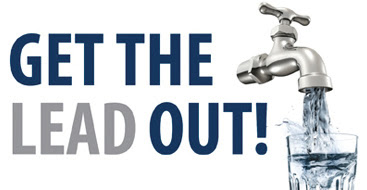 |
| How the Lead Gets In |
How do you know if your home has lead water mains coming into your house? Actually, there is a very easy way to tell if you have a lead water main. A magnet will not stick to a lead pipe but will stick to either galvanized or copper plumbing. You will need to test the pipe that is coming directly out of the wall, from the street, at the water source. Lead contamination can come from several sources. Obviously, the most common source is lead water mains coming into the home. Lead contamination can also come from copper plumbing lines that were soldered with lead core solder. This was very common up until 1987 when they passed new lead laws. Plumbers then began using solder that was 50/50 lead and zinc. Solder is now a mixture of Tin and Antimony 95/5 mix.
Many cities, like Lansing, MI, have taken a pro-active approach to this problem and began replacing their lead water lines ten years ago. It has been a pretty seamless transition, for Lansing, and they expect to have all the lead lines replaced by 2017. Lead in drinking water is a very serious concern and needs to be addressed for the health of us all. If you would like to have your water tested for lead contamination it is recommended to have it tested by a state-certified water lab.
Even if you have lead in your water there are many options to treat your home for lead removal and assure you have quality water for your family. If you suspect you have lead contamination in your plumbing the first thing you should do every morning is let the faucet run for several minutes to flush the waterline of elevated lead levels. This is the time when peak lead levels can occur after water is sitting in the plumbing lines all night causing lead to leach off into the water. Simple replaceable carbon block filters can be used under sinks for the cold water feed to remove lead and whole house lead removal systems are also available to assure your family has safe drinking water along with lead-free water for washing and bathing. One of the many options for whole-house lead removal is KDF filter media. This filter media uses a combination of copper and zinc and causes lead to plate out on the filter media holding it and the filter media would be replaced after a certain amount of gallons of water are passed through the media. This is dependent on the particular contaminant levels present. KDF filter media has some very unique properties that also neutralizes chlorine in the water at the point of entry (POE) or for point of use (POU) such as for individual faucets.
NOTE: When looking for block carbon filters, or any carbon filtration, always look for filters/carbon made in the USA. A lot of carbon is coming out of China now and the quality of the carbon is very bad. There have also been instances, with Chinese carbon, when the carbon was not rinsed properly after being acid washed and it was extremely acidic and highly corrosive! So buyer beware, this is an extreme health concern!
Below are some helpful links with important information related to your water and lead.
How to tell if your water line is lead
How to test for lead in your water.
EPA.GOV - Lead in drinking water
KDF Filter Media
CDC - Lead and Drinking Water
Healthy Child - How to filter lead from your tap water.
Inspectapedia - How to reduce lead in water.
What you need to know about water filters to remove lead
Pioneer whole house lead filtration system
Good Water, Good Life!
Beauchamp Water Treatment and Supply
872 N Old us 23 Brighton, MI 48114
810 632 2000
www.beauchampwater.com
© All rights reserved. Beauchamp Water Treatment and Supply 2016
Raymond McConnell






